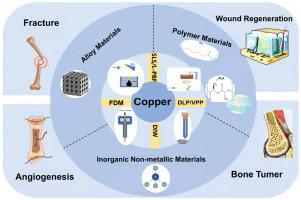Research advances, challenges and outlooks of copper-containing scaffolds derived from 3D printing for tissue repair
IF 2.3
4区 医学
Q3 ENGINEERING, BIOMEDICAL
引用次数: 0
Abstract
Bone infection and vascularization remain severe challenges in bone scaffold implantation surgery. Copper-based biomaterials have demonstrated dual functional capabilities for addressing these issues. However, achieving spatially controlled copper (Cu) content and distribution to maximize therapeutic efficacy without inducing cytotoxicity is still challenging. 3D printing technology, with its unique advantages in spatial controllability and personalized structure fabrication, provides a robust platform for developing functional copper-loaded scaffolds. This review systematically summarizes the development of 3D-printed copper-loaded biomaterial scaffolds across multiple material systems. We describe how 3D printing enables precise modulation of Cu ion release kinetics and scaffold architecture through controlled material composition and printing parameters, optimizing mechanical and biological performance. Furthermore, significant bottlenecks hindering clinical translation, particularly copper ion initialburst release and mechanical anisotropy, are highlighted. Strategies for overcoming these challenges are discussed to advance clinical translation of personalized copper-functionalized scaffolds for tissue regeneration.

组织修复用3D打印含铜支架的研究进展、挑战与展望
骨感染和血管形成仍然是骨支架植入手术的严峻挑战。铜基生物材料已经证明了解决这些问题的双重功能。然而,实现空间控制的铜(Cu)含量和分布,以最大限度地提高治疗效果而不诱导细胞毒性仍然是一个挑战。3D打印技术以其在空间可控性和个性化结构制造方面的独特优势,为开发功能铜支架提供了坚实的平台。本文系统总结了3d打印铜负载生物材料支架在多种材料体系中的发展。我们描述了3D打印如何通过控制材料成分和打印参数来精确调节Cu离子释放动力学和支架结构,优化机械和生物性能。此外,还强调了阻碍临床转化的重大瓶颈,特别是铜离子初始爆发释放和机械各向异性。讨论了克服这些挑战的策略,以推进用于组织再生的个性化铜功能化支架的临床翻译。
本文章由计算机程序翻译,如有差异,请以英文原文为准。
求助全文
约1分钟内获得全文
求助全文
来源期刊

Medical Engineering & Physics
工程技术-工程:生物医学
CiteScore
4.30
自引率
4.50%
发文量
172
审稿时长
3.0 months
期刊介绍:
Medical Engineering & Physics provides a forum for the publication of the latest developments in biomedical engineering, and reflects the essential multidisciplinary nature of the subject. The journal publishes in-depth critical reviews, scientific papers and technical notes. Our focus encompasses the application of the basic principles of physics and engineering to the development of medical devices and technology, with the ultimate aim of producing improvements in the quality of health care.Topics covered include biomechanics, biomaterials, mechanobiology, rehabilitation engineering, biomedical signal processing and medical device development. Medical Engineering & Physics aims to keep both engineers and clinicians abreast of the latest applications of technology to health care.
 求助内容:
求助内容: 应助结果提醒方式:
应助结果提醒方式:


